Flaky scalp? Itchy roots? Before you grab an anti-dandruff shampoo, let’s pause. Many people confuse dandruff and dry scalp — and while their symptoms look similar, their causes and treatments are different. Understanding the difference between dandruff and dry scalp is the key to treating it effectively and restoring scalp health.
What Is Dandruff?
Dandruff is often linked to seborrheic dermatitis, a scalp condition caused by excess oil, fungus (Malassezia), and inflammation. It leads to large, oily yellow or white flakes and persistent itchiness. Nearly 50% of adults experience dandruff at some point.
Common Causes of Dandruff:
-
Overgrowth of Malassezia (yeast-like fungus)
-
Excess scalp oil (sebum)
-
Inflammation or stress
-
Hormonal changes
-
Lack of regular cleansing
-
Poor diet or nutritional deficiencies
-
Medical conditions like psoriasis or eczema
Note: Dandruff can appear in other oily areas too — like the eyebrows, ears, and chest.
What Is Dry Scalp?
A dry scalp occurs when the skin on your scalp lacks moisture. Unlike dandruff, which is oil-related, dry scalp is linked to environmental conditions or product sensitivity. The flakes are usually smaller, whiter, and dry in texture.
Common Causes of Dry Scalp:
-
Cold, dry weather
-
Harsh shampoos or styling products
-
Over-washing hair
-
Skin conditions like eczema
-
Age-related dryness
-
Not drinking enough water
People with dry scalp often notice dryness on other parts of the body like arms or legs too.
Dandruff vs Dry Scalp: What’s the Difference?
|
Symptoms |
Dandruff |
Dry Scalp |
|
Flake Type |
Oily, yellow or white flakes |
Small, dry white flakes |
|
Itchy Scalp |
Yes |
Yes |
|
Red, greasy, scaly skin |
Often |
Rare |
|
Dry skin on other body parts |
Uncommon |
Common |
|
Trigger |
Excess oil, fungus |
Lack of moisture |
|
Affected areas |
Scalp, eyebrows, nose folds |
Mostly scalp only |
How to Treat Dandruff Naturally
-
Use an anti-dandruff hair oil like N4N’s Scalp Potion with neem and tea tree oil.
-
Wash hair regularly with a mild, sulfate-free shampoo.
-
Avoid heavy styling products and chemical-laden formulas.
-
Maintain a balanced diet with zinc and biotin.
Pro Tip: Limit stress — it can aggravate fungal growth and worsen flakes.
How to Treat Dry Scalp
-
Switch to a hydrating, fragrance-free shampoo with minimal ingredients.
-
Use natural oils like coconut oil or almond oil for deep scalp hydration.
-
Avoid overwashing — shampoo every 2–3 days.
-
Increase water intake and include omega-3-rich foods in your diet.
Try the Growth Potion Hair Oil by N4N for long-lasting scalp nourishment.
When to See a Dermatologist
If your flakes are persistent even after 3–4 weeks of home treatment, or if symptoms like redness and irritation worsen, it’s best to consult a dermatologist. You may be dealing with:
-
Chronic seborrheic dermatitis
-
Scalp psoriasis
-
Allergic reaction to haircare products
Conclusion
Though they appear similar, dandruff and dry scalp are caused by very different factors—oil vs moisture. Once you identify the cause, the treatment becomes simple and effective. Treat your scalp with care, choose natural products, and stay consistent with your routine.
With the right diagnosis and natural remedies, you’ll be flake-free in no time.


